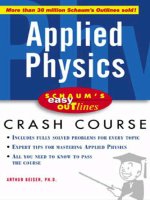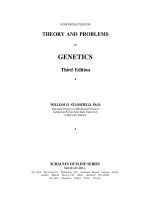Ebook Schaum''s Outline of Theory and Problems of Human Anatomy and Physiology
Bạn đang xem bản rút gọn của tài liệu. Xem và tải ngay bản đầy đủ của tài liệu tại đây (28.84 MB, 464 trang )
SCHAUM’S OUTLINE OF
THEORY AND PROBLEMS
OF
HUMAN ANATOMY
AND
PHYSIOLOGY
Second Edition
Kent NI. Van De Graaff, Ph.D.
Professor of Zoology
Weber State University
R. Ward Rhees, Ph.D.
Professor of Zoology
Brigham Young University
a
SCHAUM’S OUTLINE SERIES
McGRAW-HILL
New York St. Louis San Francisco Auckland Bogotd Caracas
Lisbon London Madrid Mexico City Milan Montreal
New Delhi San Juan Singapore
Sydney Tokyo Toronto
KENT M. VAN DE GRAAFF is currently a Professor of Zoology at Weber
State University in Ogden, Utah. He received his B.S. (1965) in Zoology at
Weber State College, his M.S. (1 969) at University of Utah, and his Ph.D. (1973)
at Northern Arizona University. He completed a postdoctorate course in neuromyology (1974), and taught anatomy at University of Minnesota and Brigham
Young University. Van De Graaff is the author or coauthor of several college
textbooks, including Human Anatomy, Concepts of Human Anatomy and
Physiology, and Synopsis of Human Anatomy and Physiology.
R. WARD RHEES is a Professor of Zoology at Brigham Young University. He
received his B.S. (1967) in Pharmacy at the University of Utah and his Ph.D.
(1971) in Physiology at Colorado State University. He taught at Weber State
College and has been a Visiting Professor in the Department of Anatomy and the
Brain Research Institute at the UCLA School of Medicine. His research on sexual differentiation of the brain has been published in numerous leading scholarly journals and presented at national and international conferences.
Schaum’s Outline of Theory and Problems of
HUMAN ANATOMY AND PHYSIOLOGY
Copyright 0 1997, 1987 by The McGraw-Hill Companies, Inc. All rights reserved.
Printed in the United States of America. Except as permitted under the Copyright Act of
1976, no part of this publication may be reproduced or distributed in any form or by any
means, or stored in a data base or retrieval system, without the prior written permission of
the publisher.
1 2 3 4 5 6 7 8 9 1 0 1 1 1 2 1 3 1 4 1 5 PRS PRS 9 0 2 1 0 9 8 7
ISBN
0-07-066887-6
Sponsoring Editor: Barbara Gilson
Production Supervisor: Pamela Pelton
Editing Supervisor: Maureen B. Walker
Library of Congress Cataloging-in-PublicationData
Van De Graaff, Kent M. (Kent Marshall), date
Schaum‘s outline of theory and problems of human anatomy and
physiology / Kent M. Van De Graaff, R. Ward Rhees.
p. cm. -- (Schaum’s outline series)
Includes index.
ISBN 0-07-066887-6
1. Human physiology--Outlines, syllabi, etc. 2. Human physiology-Problems, exercises, etc. 3. Human anatomy--Outlines, syllabi,
etc. 4.Human anatomy--Problems, exercises, etc. I. Rhees, R.
Ward. 11. Title 111. Series.
QP41.V36 1997
6 12--dc21
McGraw-Hill
A Division of TheMcGraw.HiU Companies-
-
97-8 163
CIP
To Karen and Karin
This page intentionally left blank
Mastery of the science of human anatomy and physiology is important for students who are planning careers in healthrelated fields such as medicine, nursing, dentistry, medical technology, physical therapy, and athletic training. The focus
of the second edition of Schaum's Outline of Human Anatomy and Physiology is on presenting practical information that
students will be able to apply to real-world situations they might encounter in their chosen discipline. In addition, numerous examples throughout this study outline reinforce the principle that learning anatomy and physiology helps students
become better acquainted with themselves. The integration of anatomy and physiology in this study outline provides students with a focused perspective of body structure and function. The organization, level of rigor, and clinical focus of this
study outline is especially appropriate for students preparing for health-relatecl careers. In addition, this study outline provides students with an organized means of preparing for aspects of national MCAT, DAT, or allied health board certification examinations.
The topic sequence and content of this edition is designed to accompany any human anatomy and physiology textbook. If
used as a supplement to a text and class notes, this study outline will improve a student's efficiency of study and performance on course examinations.
The organization of Schaum's Outline of Human Anatomy and Physiology is carefully designed to enhance learning. Each
chapter is composed of objective-survey-problems modules. An objective represents a major topic and level of competency that a student should strive to achieve. A topic survey follows the objective and is identified with a magnifying glass
icon. The survey is a carefully phrased body of information that gives the essence of the topic introduced in the objective.
The problems and answers that follow the survey will test a student's understa.ndingof the subject and provide additional
information to meet the objective at the desired level.
Set off from the text narrative are short paragraphs highlighted by accompanying topic icons. This interesting information
is relevant to the discussion that precedes it. The three icons used are as follows:
Clinical information is indicated by a physician's staff.
@s
A
Developmental information of practical importance is indicated by a human embryo.
mb
is indicated by a balance.
&
Schaum's Outline of Human Anatomy and Physiology is much more than just words. Because anatomy and physiology are
visually oriented sciences, the preparation of an effective art program was a top priority in this edition. An abundance of
carefully rendered figures supplements the text to maximize the learning effort. In addition to the anatomical renderings,
flowchart figures are used throughout this study guide to clarify physiological processes. Each figure is placed as close as
possible to its text reference.
New features to this edition include developmental, homeostatic, and additional clinical concepts related to the major topics. These new pedagogical features provide information concerning the development of body organs and facilitate the students comprehension of interactions of body systems. New figures, figure captions, and tables have been added to further
complement the written material. Also, the labeling has been completely redone to enhance and improve the illustrations.
At the close of each chapter is a set of review questions with complete answers by which students can measure their understanding of the concepts and information. Key clinical terms are defined at the end of chapters. The Outline is completed
with a comprehensive index.
Several individuals assisted in the preparation of this outline, and sincere thanks is extended to each. Christopher H. Creek
and Scott Schwendiman rendered the illustrations. Rendell Ashton and Joseph Ashton provide student input regarding the
effectiveness of the questions. Special appreciation is expressed to Ann Mirels. for her exceptional input as a copy editor.
Michael W. Hancock and John L. Crawley were indispensible in the layout of the final product. Finally, we are appreciative of Maureen Walker of McGraw-Hill for her encouragement and editorial assistance in the completion of this project.
KENTM. VANDE GRAAFF
R. WARDRHEES
This page intentionally left blank
Contents
Chapter
1
INTRODUCTION TO THE HUMAN BODY ....................................................
1
Chapter
2
CELLULAR CHEMISTRY ..................................................................................
22
Chapter
3
CELL STRUCTURE AND FUNCTION..............................................................
39
Chapter
4
TISSUES..................................................................................................................
54
Chapter
5
INTEGUMENTARY SYSTEM ............................................................................
71
Chapter
6
SKELETAL SYSTEM ..........................................................................................
88
Chapter
7
MUSCLE TISSUE AND MODE OF CONTRACTION ....................................
123
Chapter
8
MUSCULAR SYSTEM ........................................................................................
137
Chapter
9
NERVOUS TISSUE ..............................................................................................
166
Chapter
10
CENTRAL NERVOUS SYSTEM ........................................................................
182
Chapter
11
PERIPHERAL AND AUTONOMIC NERVOUS SYSTEM..............................
204
Chapter
12
SENSORY ORGANS ............................................................................................
224
Chapter
13
ENDOCRINE SYSTEM ........................................................................................
243
Chapter
14
CARDIOVASCULAR SYSTEM: BLOOD..........................................................
265
Chapter
15
CARDIOVASCULAR SYSTEM: THE HEART ................................................
278
Chapter
16
CARDIOVASCULAR SYSTEM: VESSELS AND BLOOD
Chapter
17
LYMPHATIC SYSTEM AND BODY IMMUNITY ..........................................
312
Chapter
18
RESPIRATORY SYSTEM ....................................................................................
328
Chapter
19
DIGESTIVE SYSTEM ..........................................................................................
346
Chapter
20
METABOLISM. NUTRITION. AND TEMPERA'I'URE
Chapter
21
URINARY SYSTEM..............................................................................................
387
Chapter
22
WATER AND ELECTROLYTE BALANCE .......................................................
404
Chapter
23
REPRODUCTIVE SYSTEM ................................................................................
413
INDEX ....................................................................................................................
441
CIRCULATION ....................................................................................................
REGULATION ......................................................................................................
298
371
This page intentionally left blank
Introduction to the
Human Bodv
J
1
Objective A To describe anatomy and physiology as scientific disciplines and to explain
how they are related.
1.1
Anatomy and physiology are subdivisions of the science of biology, which
is the study of living organisms, both plant and animal. Human anatomy has
to do with body structure and the relationships between body structures.
Human physiology is concerned with the functions of the body parts. In
general, function is determined by structure.
6"
rveY
What are the subspecialties of human anatomy?
These include: gross anatomy, the study of structures observed with the unaided eye; microscopic
anatomy, the study of structures observed with the aid of a microscope (cytology is the study of
cells and their organelles, and histology is the study of tissues that make up organs); developmental
anatomy, the study of structural changes from conception to birth; and pathological anatomy
(pathology), the study of structural changes caused by disease.
1.2
What are the subspecialties of human physiology?
These include cellular physiology, the study of the interactions of cell parts and the specific
functions of the organelles and the cell in general; developmental physiology, the study of
functional changes that occur as an organism develops; and pathological physiology, the study of
the functional changes that occur as organs age or become diseased.
Objective B To describe the human organism with reference to a classification scheme
and to list the physical requirements for life.
P
Homo sapiens, as we have named ourselves, is a biological organism that
rvey has features in common with all living animals. Because we have
characteristics unique to us, we are a species within a classification scheme
based on similarity of structural features.
1.3
Explain why humans are classed among the animals.
We breathe, eat and digest food, excrete body wastes, locomote, and reproduce our own kind, as do
other animals. Being composed of organic materials, we decornpose in death as other animals
(chiefly microorganisms) consume our flesh. The processes by which our bodies produce, store,
and utilize energy are similar to those used by all living organisms. The same genetic code that
regulates our development is found throughout nature. The fundamental patterns of development
observed in many animals are also seen in the formation of the human embryo.
1.4
What are the basic physical requirements for the survival of an organism?
Water, for a variety of metabolic processes; food, to supply energy, raw materials for building new
living matter, and chemicals necessary for vital reactions; oxygen, to release energy from food
materials; heut, to promote chemical reactions; and pressure, to allow breathing.
1.5
Classify human beings using taxonomic categories.
The descending series is shown in table 1.1. Homo sapiens is the only extant (existing) hominid.
2
Chapter 1
Introduction to the Human Body
Table 1.1 Classification of Human Beings
Characteristics
I
Cells having a visible nucleus but lacking walls,
plastids, and photosynthetic pigments
-".--.--Notochord; dorsal hollow nerve cord;
pharyngeal pouches
Chordata
Cartilaginous or bony endoskeleton; vertebral
column
Mammalia
Hair; mammary glands; three auditory ossicles;
--- attached placenta; muscular diaphragm
Prehensile hands with digits modified for
Primates
grasping; large brains
t
-..""."""-----Large, well-developed cerebrum; flattened face;
Hominidae
---bipedal posture and locomotion; well-developed
1 Homo--vocal structures; opposable thumb
sapiens
!
Phylum
-"-"
,"---
I
Class
Order
I
Family
Genus
Species
I
Objective c To describe the levels of organization of the human body.
The chemical and cellular levels are respectively the basic structural and
functional levels. Each level of body organization (fig. 1.1) represents an
association of units from the preceding level. Although the cells in the adult
body number in the trillions, there are only a few hundred specific kinds.
2 hemica' Cellular
Atom
r
-
Tissue
*
System
Organ
- *
I
Stomach
Cells
Organism
-
c
Digestrve
system
"@
Molecule
Epithelia1
cells
Figure 1.1 Levels of body organization. The chemical, cellular, and tissue levels are
microscopic, whereas the organ, system, and organismic levels are macroscopic.
1.6
How are similar cells bound together?
Similar cells are uniformly spaced and bound together as tissue by nonliving matrix, which the
Chapter 1
Introduction to the Human Body
3
cells secrete. Matrix varies in composition from one tissue to another and may take the form of a
liquid, semisolid, or solid. Blood tissue, for example, has a liquid matrix, while bone cells are
bound by a solid matrix. Not all similar cells, however, have a binding matrix; secretory cells, for
instance, are solitary amidst a tissue of cells of another kind.
1.7
Define the term tissue and explain why the study of tissues is important.
A tissue is an aggregation of similar cells bound by supporting matrix that performs a specific
function. Histology is the microscopic science concerned with the study of tissues. Pathology is the
medical science concerned with the study of diseased tissues..Tissues are described in chapter 4.
1.8
List the four principal types of tissues and describe the functions of each.
Epithelia1 tissue (epithelium)covers body and organ surfaces, lines body cavities and lumina
(hollow portions of body tubes), and forms various glands. Epithelia1 tissue is involved with
protection, absorption, excretion, and secretion.
Connective tissue binds, supports, and protects body parts.
Muscle tissue contracts to produce movement of body parts and permit locomotion.
Nervous tissue initiates and transmits nerve impulses that coordinate body activities.
1.9
Use an example to define the term organ and describe the function of that organ.
A bone, such as the femur, is an organ because it is composed of several tissue types that are
integrated to perform a particular function. The components of the femur include bone tissue,
nervous tissue, vascular (blood) tissue, and cartilaginous tissue (at a joint). Not only does the
femur, as part of the skeletal system, help to maintain body support, it also serves the muscular
system by providing a place of attachment for muscles, and the circulatory system by producing
blood cells in the bone marrow.
Vital body organs are those that are essential for critical body
functions. Examples are the heart in pumping blood, the liver in
processing foods and breaking down 'worn blood cells, the kidneys in
filtering blood, the lungs in exchanging respiratory gasses, and the
brain in controlling and correlating body functions. The reproductive
organs are not vital body organs, nor are the organs within the appendages. Death of
a person occurs when one or more of the vital body organs falters in its function.
-)L-
1.10
Define the term system as it applies to body organization.
A system is an organization of two or more organs and associated structures working as a unit to
perform a common function or set of functions, for example, the flow of blood through the body in
the case of the circulatory system. Some organs serve more than one body system. The pancreas
serves the digestive system in production and secretion of digestive chemicals (pancreatic juice)
and the endocrine system in the production of hormones (chemical messengers, insulin, and
glucagon). The basic structure and function of each of the body systems is presented in fig. 1.2
through fig. 1.1I.
With the exception of the reproductive system, all of the organs that make
up the body systems are formed within the 6-week embryonic period (from
the beginning of the third week to the end of the eighth week) of prenatal
development. Not only are the vital body organs and systems formed
during this time, many of them become functional. For example, 25 days
after COIiception the heart is pumping blood through the circulatory system. The
organs of the reproductive system form between 10 and 12 weeks after conception,
but they do not mature and become functional until a. person goes through puberty
at about age 12 or 13.
Q
4
Introduction to the Human Body
Chapter 1
DEFINITION The integument (skin) and structures
derived from it (hair, nails, and oil sweat glands).
DEFINITION Bones, cartilage, and ligaments (which
guy the bones at the joints).
FUNCTlONS Protects the body, regulates body
temperature, eliminates wastes, and receives certain
stimuli (tactile, temperature, and pain).
FUNCTIONS Provides body support and protection,
permits movement and leverage, produces blood cells
(hemopoiesis), and stores minerals.
Figure 1.2 Integumentary system.
Figure 1.3 Skeletal system.
DEFINITION Skeletal muscles of the body and their
tendinous attachments.
DEFINITlON Brain, spinal cord, nerves, and sensory
organs such as the eye and the ear.
FUNCTIONS Effects body movements, maintains
posture, and produces body heat.
FUNCTIONS Detects and responds to changes in
internal and external environments, enables reasoning
and memory, and regulates body activities.
Figure 1.4 Muscular system.
Figure 1.5 Nervous system.
Chapter 1
Introduction to the Human Body
DEFINITION The hormone-producing glands.
FUNCTIONS Controls and integrates body functions
via hormones secreted into the bloodstream.
Figure 1.6 Endocrine system.
5
DEFINITION The body organs that render ingested
foods absorbable.
FUNCTIONS Mechanically and chemically breaks
down foods for cellular use and eliminates undigested
wastes.
Figure 1.7 Digestive system.
DEFINITION The body organs concerned with
movement of respiratory gases (0, and CO,) to and
from the pulmonary blood (the blood within the lungs).
FUNCTIONS Supplies oxygen to the blood and
eliminates carbon dioxide; also helps to regulate acidbase balance.
Figure 1.8 Respiratory system.
DEFINITION The heart and the vessels that carry
blood or blood constituents (lymph) through the body.
FUNCTIONS Transports respiratory gases, nutrients,
wastes, and hormones; protects against disease and
fluid loss; helps regulate body temperature and acidbase balance.
Figure 1.9 Circulatory system.
6
Introduction to the Human Body
Chapter 1
DEFINITION The organs that operate to remove wastes
from the blood and to eliminate urine from the body.
FUNCTIONS Removes various wastes from the blood;
regulates the chemical composition, volume, and
elecrolyte balance of the blood; helps maintain the acidbase balance of the body.
Figure 1.10 Urinary system.
DEFINITION The body organs that produce, store, and transport reproductive cells (gametes,or sperm and ova).
FUNCTIONS Reproduce the organism, produce sex hormones.
Figure 1.11 Male and female reproductive systems.
Chapter 1
Introduction to the Human Body
7
objective D To list the body systems and to describe the general functions of each.
1.11
Which body systems function in support and movement?
The muscular and skeletal systems are frequently referred to as the musculoskeletal system because
of their combined functional role in body support and locomotion. Both systems, along with the
movable (synovial) joints, are studied extensively in kinesiology (the mechanics of body motion).
The integumentary system also provides some support, and its flexibility permits movement.
1.12
Which body systems function in integration and coordination?
The endocrine system and nervous system maintain consistency of body functioning, the former by
secreting hormones (chemical substances) into the bloodstream and the latter by producing nerve
impulses (electrochemical signals) carried via neurons (nerve cells).
1.13
Which body systems are involved with processing and transporting body
substances?
Nutrients, oxygen, and various wastes are processed and transported by the digestive, respiratory,
circulatory, lymphatic, and urinary systems. The lymphatic system, which is generally considered
part of the circulatory system, is composed of lymphatic vessels, lymph fluid, lymph nodes, the
spleen, and the thymus. It transports lymph from tissues to the bloodstream, defends the body
against infections, and aids in the absorption of fats.
Diseases or functional problems of the circulatory system are of major clinical
importance because of the potential for disruption of blood flow to a vital
organ. Arteriosclerosis, or hardening of the arteries, is a generalized
degenerative vascular disorder that results in the loss of elasticity and
thickening of the arteries. Atherosclerosis is a type of arteriosclerosis in which
plaque material called atheroma forms on the inside lining of vessels. A thrombus is
a clot within a vessel. An aneurysm is an expansion ‘orbulging of an artery, whereas
a coarctation is a constriction of a segment of a vessel.
B
Objective E To explain what is meant by homeostasis.
Homeostasis is the process by which a nearly stable internal env ronment is
maintained in the body so that cellular metabolic functions can proceed at
maximum efficiency. Homeostasis is maintained by effectors (generally
muscles or glands), which are regulated by sensory information from the
internal environment.
1.14
What major regulatory process does the body use to maintain homeostasis?
Essentially all the control systems of the body are regulated by negative feedback. If a factor of the
internal environment deviates from a set point, then the system that monitors that factor initiates a
counterchange (hence “negative”) that returns the factor to its normal state. A specific example is
presented in fig. 1.12.
1.15
What is the relationship between homeostasis and pathophysiology?
They are opposed in meaning in the sense that health reflects homeostasis, whereas abnormal
function-i.e., pathophysiology-marks a deviation from homeostasis. Pathophysiology is the basis
for diagnosing disease and instituting treatment intended to restore normal function.
8
Chapter 1
Introduction to the Human Body
Fight or flight
response-accompanying
stress
Controlled condition
/-
t
Blood pressure
Baroreceptors
Nerves sensitive to pressure in
blood vessels
Nerve
input
Return to homeostasis;
blood pressure drops to
normal
Control center
Vasomotor area
Response
J. Blood pressure
Figure 1.12 Homeostasis of blood pressure. Feedback mechanisms in the form of input
(stimulus), a monitoring center, and output (response) maintain dynamic
constancy.
Objective F To describe the anatomical position.
All terms of direction that describe the relationship of one body part to
another are made in reference to a standard anatomical position (fig. 1.13).
In the anatomical position, the body is erect, feet are parallel and flat on the
floor, eyes are directed forward, and arms are at the sides of the body with
the palms of the hands turned forward and the fingers pointing downward.
1.16
Why are the palms given an orientation that seems unnatural?
During early embryonic development, the palms are supine (facing forward or upward). Later, an
axial rotation of each forearm puts the palms in a prone position (facing backward or downward).
Thus, the anatomical position orients the upper extremities as in early development.
Chapter 1
Introduction to the Human Body
9
Objective G To identify the planes of reference used to locate and describe structures
within the body.
A set of three planes (imaginary flat surfaces) passing through the body is
frequently used to depict structural arrangement. The three planes are
termed the midsagittal, coronal, and transverse planes.
Figure 1.13 For descriptive purposes,
the anatomical position provides a
standard reference framework
for the body.
1.17
Figure 1.14 Planes of reference through
the body.
Distinguish between the principal body planes.
The midsagittal plane is the plane of symmetry of the body, dividing it into right and left halves.
Sagittal (parasagittal) planes run parallel to the midsagittal plane; they divide the body into
unequal right and left portions. Corona1 (frontal) planes divide the body into front and back
portions. Transverse (horizontal or cross-sectional) planes divide the body into superior (upper)
and inferior (lower) portions. These planes are shown in fig. 1.14.
1.18
With reference to the planes of the body, discuss the advantage of CT (CAT) scans
and MRIs over conventional X rays.
Conventional radiographs ( X rays) are of limited clinical value because they are taken on a vertical
plane, and thus images of various structures are often superimposed. One major advantage of
computerized tomographic images (CT scans) and magnetic resonance images (MRIs) is that they
can display images along transverse or sagittal planes. These images are similar to those that could
otherwise be obtained only in actual sections through the body.
Chapter 1
Introduction to the Human Body
10
Objective H To identify and locate the principal body regions.
The principal body regions are the head, neck, trunk, upper extremity (two),
and lower extremity (two). The trunk (torso) is frequently divided into the
thorax and abdomen.
1.19
State the regions that contain the brachium, cubital fossa, popliteal fossa, and
axilla.
Specific structures or clinically important areas within the principal regions have anatomical names
(see fig. 1.15). Learning the specific regional terminology provides a foundation for learning the
names of underlying structures later on.
'Head
f
\Anterior
4
Cervical
..--.--
.Neck
Deltoid (shoulder)
thorax
thorax
Axillary region
(axilla)
Antebrachium
(forearm)
Buttock
Wrist
1
Thigh
Popliteal fossa
Calf of leg
Ankle
Plantar surface
(a)
Figure 1.15
(b)
The principal body regions. ( a ) An anterior view and (b) a posterior view.
Objective I To identify and to locate the principal body cavities and the organs within
them.
Body cavities are confined spaces in which organs are protected, separated,
and supported by associated membranes. As shown in fig. 1.16, the
posterior (dorsal) cavity includes the cranial and vertebral cavities (or
vertebral canal) and contains the brain and spinal cord. The anterior
(ventral) cavity includes the thoracic, abdominal, and pelvic cavities and
Chapter 1
Introduction to the Human Body
11
contains visceral organs. The abdominal cavity and the pelvic cavity are frequently
referred to collectively as the abdominopelvic cavity. Body cavities serve to
segregate organs and systems by function. The major portion of the nervous system
occupies the posterior cavity; the principal organs of the respiratory and circulatory
systems are in the thoracic cavity; the primary organs of digestion are in the
abdominal cavity; and the reproductive organs are in the pelvic cavity.
Figure 1.16 The principal body cavities. ( a )An anterior view and ( h ) a midsagittal view.
1.20
What are visceral organs?
Visceral organs, or viscera, are those that are located within the anterior body cavity. Viscera of
the thoracic cavity include the heart and lungs. Viscera of the abdominal cavity include the
stomach, small intestine and large intestine, spleen, liver, and gallbladder.
1.21
Where are the pleural and pericardial cavities?
The thoracic cavity is partitioned into two pleural cavities, one for each lung, and the pericardial
cavity, surrounding the heart. The area between the two lungs is known as the mediastinum.
1.22
What is the clinical significance of the thoracic organs being in separate
compartments ?
Because each thoracic organ is positioned in its own compartment, trauma is minimized and the
risk of disease spreading from one organ to another is reduced. Although the lungs function
together, they also work independently, Trauma may cause one lung to collapse, but the other will
remain functional.
12
Introduction to the Human Body
Chapter 1
Objective J To discuss the types and functions of the various body membranes.
P
Body membranes are composed of thin layers of connective and epithelial
rvey tissue. They serve to cover, protect, lubricate, separate, or support visceral
organs or to line body cavities. The two principal types are mucous
membranes and serous membranes.
1.23
What are the functions of mucous membranes?
Mucous membranes secrete a thick, viscid substance, called mucus, that lubricates and protects
the body organs where it is secreted.
1.24
Which of the following organs are lined, at least in part, with mucous membranes?
(a)the trachea, (b)the stomach, ( c ) the uterus, (d) the mouth and nose
The inside walls of all the organs listed are lined with mucous membranes. Mucus in the nasal
cavity and trachea traps airborne particles; mucus in the oral cavity prevents desiccation (drying);
mucus coats the epithelial lining of the stomach to protect against digestive enzymes and
hydrochloric acid; and mucus in the uterus protects against the entry of pathogens.
Mucous membranes are the first line of defense in locations such as
the nasal and oral cavities and in the uterine cavity. Being warm,
moist, and highly vascular, mucous membranes are vulnerable to
pathogens. However, the acidic pH of the secreted mucus in these
locations effectively kills most microorganisms. Mucous membranes
occasionally do become infected, in which case other body immunity responses are
called into action. A cold or a sore throat is an infection of mucous membranes, and
swelling and congestion are among of the first responses to fight the infection.
1.25
Describe the composition and general locations of the serous membranes and
distinguish these membranes from mucous membranes.
Serous membranes line the thoracic and abdominopelvic cavities and cover visceral organs. They
are composed of thin sheets of epithelial tissue (simple squamous epithelium) that lubricate,
support, and compartmentalize visceral organs. Serous fluid is the watery lubricant they secrete.
1.26
Give the specific locations of the individual serous membranes.
See table 1.2 and fig. 1.17.
Cavity
I
Table 1.2 Serous Membranes and Their Locations
SerousMembrane
I
Location
I
Chapter 1
Introduction to the Human Body
13
Figure 1.17 The serous membranes and their associated visceral organs. (a) An anterior
view and (b)a midsagittal view.
Pleurisy is an inflammation of the pleural membranes associated with a lung.
The infection is generally confined to just one of the pleural cavities. Trauma
to a pleural cavity (such as from a crushed rib cage or a bullet or knife wound)
condition known as a
may permit air to enter the pleural cavity-a
mothorax. Blood in a pleural cavity is known as a hemothorax. A pneumothorax
causes the lung on the affected side to collapse. The compartmentalization of
thoracic organs, however, ensures that one of the lungs will remain functional.
1.27
Define peritoneal cavity and explain what is meant by a retroperitoneal organ.
The parietal peritoneum is a thin membrane attached to the inside of the abdominal wall. It is
continuous around the intestinal viscera as the visceral peritoneum. The peritoneal cavity is the
space between the parietal and visceral portions of the peritoneum. Retroperitoneal organs, such as
the kidneys, adrenal glands, and a portion of the pancreas, are positioned behind the parietal
peritoneum, but are still within the abdominopelvic cavity.
Peritonitis is an inflammation of the peritoneal membrane. The infection is
confined to the peritoneal cavity. Normally this cavity is aseptic, but it can
become contaminated by trauma, rupture of a visceral organ (e.g., a ruptured
appendix), an ectopic pregnancy (abnormal pregnancy site), or postoperative
complications. Peritonitis is usually extremely painful and life threatening.
Treatment usually involves the injection of massive doses of antibiotics and perhaps
peritoneal intubation to permit drainage.
14
1.28
Chapter 1
Introduction to the Human Body
State the function of the mesenteries.
The mesenteries are double-layered membranes that support the abdominopelvic viscera in a
pendent fashion so that intestinal peristalsis (rhythmic waves of muscular contraction) will not be
impeded. The mesenteries also support the vessels and nerves that serve the viscera.
Objective K To become familiar with the descriptive and directional terms that are
applied to anatomical structures.
and directional terms are used to communicate the position of
'@ Descriptive
structures,
..
surfaces, and regions of the body with respect to anatomical
position.
lr
1.29
Define the important descriptive and directional terms and illustrate their usage.
Some of the more commonly used descriptive and directional terms are listed in table 1.3.
I
Table 1.3 Commonly Used Descriptive and Directional Terrns
Term
I
Definition
I
Example
s superior to the abdomen.
legs are inferior to the trunk.
on the anterior side of the bodv,
The ears are lateral to the head.
--
rain is internal to the cranium.
nd is d&&l to the elbow.
Chapter 1
Introduction to the Human Body
15
Review Exercises
Multiple Choice
1. Production of secretory materials within cells would be studied as part of the science
of ( a )histology, (b)cytology, ( c ) developmental biology, (6)absorption, ( e ) anatomy.
2. A fingernail is a structure belonging to what body system? ( a ) skeletal,
( b ) circulatory, (c) integumentary, (6)lymphatic, ( e ) reticuloendothelial
3. Which two body systems are regulatory? ( a ) endocrine, (b)nervous, ( c )muscular,
(d) skeletal, ( e )circulatory
4. The region of the body between the head and thorax is most appropriately referred to
as ( a ) the lumbar region, (b)the throat region, ( c ) the trunk region, (d)the cervical
region, ( e ) the gullet region.
5. A person in the anatomical position would be ( a )lying face down; (b)lying face up;
( c ) standing erect facing forward; (d)in a fetal position.
6. In anatomical position, the thumb is ( a )lateral, (b)medial, (c)proximal,
(6)horizontal, ( e ) superficial.
7. Which is not one of the four principal tissue types? ( a ) nervous tissue, ( h )bone
tissue, (c)epithelia1 tissue, (4
muscle tissue, (e) connective tissue
8. Which is not a serous membrane? ( a )parietal peritoneum, (b)mesentery, (c)visceral
pleura, (6)lining of the mouth, ( e )pericardium
9. The relationship between structure and function of an organ is best described as ( a ) a
negative feedback system, (h)one in which function is determined by structure,
( c )important only during homeostasis of the organ system, (d)nonexistent, except in
certain parts of the body.
10. Which is not a chordate characteristic? ( a ) a vertebral column, ( h ) a notochord,
( c )pharyngeal pouches, (d) a dorsal hollow nerve cord.
11. The abdominal cavity contains ( a )the heart, (b)the lungs, ( c )the spleen, ( e ) the
trachea.
12. The ventral body cavity comprises all of the following cavities except ( a ) the spinal
cavity, (b)the pleural cavity, (c) the thoracic cavity, (6)the pelvic cavity, ( e ) the
abdominal cavity.
13. The antebrachium is ( a )the chest area, (b)the hand, ( c )the shoulder region, (d)the
armpit, ( e ) the forearm.
14. Which is positioned retroperitoneally? ( a ) stomach, (b)kidney, (c)heart,
(d)appendix, ( e ) liver
15. The foot is to the thigh as the hand is to ( a )the brachium, (b)the shoulder, (c) the
palm, (4
the digits.
16. Which term best defines the position of the knee relative to the hip? ( a ) lateral,
(b)medial, ( c )distal, (d)posterior, ( e ) proximal
16
Introduction to the Human Body
Chapter 1
17. The thoracic cavity is separated from the abdominopelvic cavity by ( a ) the
mediastinum, (b)the abdominal wall, ( c ) the sternum, (6) the abdominal septum,
(e) the diaphragm.
18. Long-distance regulation is accomplished via bloodborne chemicals known as
( a ) blood cells, (b)hormones, ( c ) ions, (6)motor impulses (e) neurotransmitters.
19. Which serous membrane would be cut first as a physician removes an infected
appendix? ( a ) parietal peritoneum, (b)dorsal mesentery, (c)visceral pleura,
(6) parietal pleura
20. If an anatomist wanted to show the structural relationship of the trachea, esophagus,
neck muscles, and a vertebra within the neck, which body plane would be most
appropriate? ( a ) sagittal plane, (b)corona1 plane, ( c )transverse plane, (6)vertical
plane, (e) parasagittal plane
21. Which pairing of directional terms most closely approximates opposites? ( a ) medial
and proximal, (h) superior and posterior, (c)proximal and lateral, (6)superficial and
deep
22. A lung is located within ( a ) the mediastinal, pleural, and thoracic cavities; ( h ) the
thoracic, pleural, and ventral cavities; ( c )the peritoneal, pleural, and thoracic
cavities; (6)the pleural, pericardial, and thoracic cavities; ( e ) none of the preceding.
23. Which of the following serous membrane combinations lines the diaphragm?
( a ) visceral pleura-visceral peritoneum, (b)visceral pleura-parietal peritoneum,
( c )parietal pleura-parietal peritoneum, (6)parietal pleura-visceral peritoneum
24. In a negative feedback system, ( a ) input is always maintained constant
(homeostatic), (b)input serves no useful purpose, ( c ) output is partially put back into
the system, (6)output is always maintained constant.
25. What is the proper sequence of body cavities or areas traversed as blood flows from
the heart to the uterus through the aorta and the uterine artery? ( a ) thoracic,
pericardial, pelvic, abdominal; (b)pericardial, mediastinal, abdominal, pelvic;
(c) pleural, mediastinal, abdominal, pelvic; (6)pericardial, pleural, abdominal,
pelvic.
True or False
1. Histology is the microscopic examination of tissues.
2. The function of an organ is predictable from its structure.
3. A group of cells cooperating in a particular function is called a tissue.
4. In anatomical position the subject is standing erect, the feet are together, and
the arms are relaxed to the side of the body with the thumbs forward.
5. A sagittal plane divides the body into right and left halves.
6. The thumb is lateral to the other digits of the hand and distal to the
antebrachium.
7. The lungs are kept moist through the secretion of mucus from mucous
membranes.









